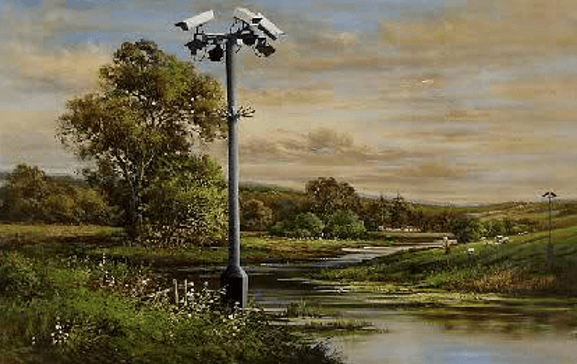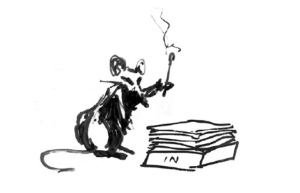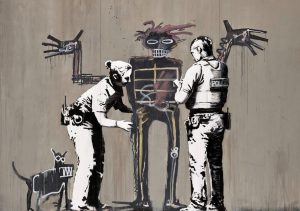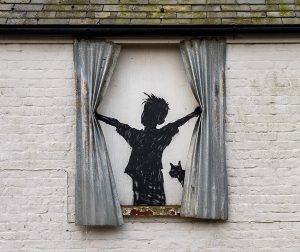
Study for Happy Chopper, 2003
Spray-paint on found framed oil painting
79 x 109.7 cm (31 1/8 x 43 1/4 inches)
Unique
Taking a found oil painting as its base, the present work makes manifest this aversion to the blank canvas and the neutral space. Whilst its provenance is unknown, the original work suggests the tradition of British landscape painting. It depicts a rather gaudy pastoral scene replete with copses, cottages, and a gently winding river. The painter imagines a kitsch landscape: a rural panorama which Banksy boldly subverts. In the original painting, the heavy storm clouds lend a note of discordance to the work, threatening the serenity of the scene below. Through Banksy’s revision, the discordance is compounded; rendered in blurred yet imposing detail is an Apache helicopter. It hovers in the foreground, pointedly incompatible with the rest of the image. The piece is arresting in its incongruity; spray paint disrupts oil paint, and mechanized warfare disrupts rural quietude. Brutal modernity, Banksy implies, precludes the creation of idealized space. Overlaid with the stark aggression of machinery, the rural scene appears ridiculous in its gentility.
Study for Happy Chopper is one of several defaced oil paintings by Banksy, each of which sees an idealized rural scene debased by an emblem of modernity. In another work, the seclusion of a riverside path falls under the unerring gaze of a CCTV column. Banksy envisages dystopian landscapes in which the dangerous potentials of technology are realized; in these works, public surveillance and military aggression make a mockery of pastoral idylls.

The Apache helicopter is a recurrent motif in the reworked paintings, as it is in much of Banksy’s work. A significant part of his aesthetic vocabulary, his stenciled helicopter is often adorned with a yellow or pink ribbon, and frequently signifies the Iraq War. The present lot shares this sentiment; belonging to a series entitled Crude Oils, it references a contemporary controversy – principally that surrounding the Iraq War. The conflict was the subject of considerable debate, and accusations were made that coalition military action was motivated by Iraq’s supply of oil. The present lot gestures towards this debate; the title refers not only to the materiality of the piece but also to the political climate of the time. The work rebukes authority, putting wordplay and visual effrontery to dissenting effect. This willingness to engage boldly and unapologetically with world events characterizes much of Banksy’s work.
Source: Phillips



